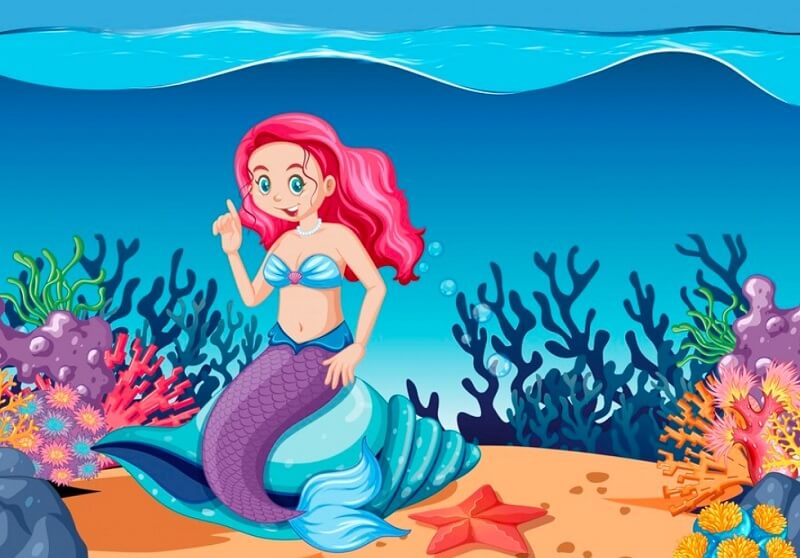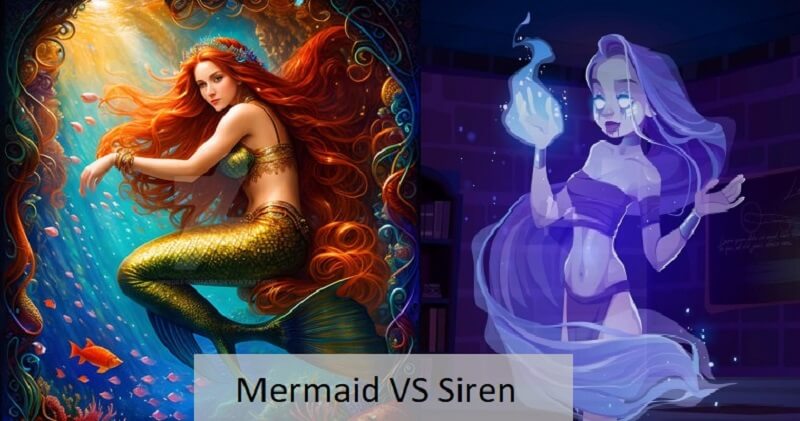In the vast ocean of mythology and folklore, few creatures have captured human imagination quite like mermaids and sirens. These enigmatic beings have long been the subject of fascination, fear, and fantasy across cultures and centuries. While often confused or used interchangeably in popular culture, mermaids and sirens are distinct mythological entities with unique characteristics, origins, and cultural significance. This article dives deep into the world of these captivating creatures, exploring similarity and difference between mermaid and siren, and examining their enduring impact on literature, art, and modern culture. From their origins in ancient myths to their representations in contemporary media, we’ll unravel the complex tapestry of legends surrounding mermaids and sirens.
Origins and Mythology
Mermaids

Mermaids have their roots in various cultures around the world, each with its own interpretation of these aquatic beings. In Greek mythology, mermaids were often associated with the sea nymphs known as Nereids, daughters of the sea god Nereus. Slavic folklore speaks of Rusalkas, water spirits that could be both benevolent and malevolent.
One of the most famous mermaid tales is Hans Christian Andersen’s “The Little Mermaid,” which has significantly shaped modern perceptions of these creatures. This story, with its themes of love, sacrifice, and transformation, has become a cornerstone of mermaid lore in Western culture.
Sirens
Sirens, on the other hand, have a more specific origin in Greek mythology. They first appeared in Homer’s epic poem “The Odyssey,” where they were described as dangerous creatures whose enchanting songs lured sailors to their doom. Originally, sirens were not associated with the sea but were creatures of the land and air, often depicted as bird-like beings with women’s heads.
In Greek myth, the sirens were said to be the companions of Persephone, daughter of Zeus. When Persephone was abducted by Hades, the sirens were given wings by Demeter to search for her. Their failure in this task led to their transformation into the dangerous beings of legend.
Physical Characteristics Difference between Mermaid and Siren
Mermaids
The classic image of a mermaid is that of a beautiful woman from the waist up, with the tail of a fish below. This depiction has remained largely consistent across cultures, though variations exist. In some traditions, mermaids may have green or blue-tinged skin, reflecting their aquatic nature. Their fish tails are often portrayed as shimmering and iridescent, covered in scales that can range from silver to vibrant hues of blue, green, or even rainbow colors.
Mermaids are typically depicted with long, flowing hair that they are often seen combing while sitting on rocks. This image, popularized by artists and storytellers over centuries, has become an iconic representation of mermaid beauty and allure.
Sirens
The physical appearance of sirens has undergone significant changes over time. In early Greek art and literature, sirens were portrayed as bird-like creatures with women’s heads. They had feathered bodies, clawed feet, and wings, resembling harpies in some respects.

However, as myths evolved and merged, sirens began to be depicted more similarly to mermaids, with human upper bodies and fish-like lower halves. This transformation in their representation reflects the fluid nature of mythology and the blending of different cultural traditions over time.
Difference in Temperament and Behavior
Mermaids
Mermaids’ temperaments vary widely across different myths and stories. In some tales, they are portrayed as benevolent beings, rescuing sailors from storms or bestowing gifts upon humans. These positive depictions often show mermaids as curious about the human world, sometimes even falling in love with mortals.
However, other legends paint a darker picture. Some stories describe mermaids as dangerous seductresses who lure sailors to watery graves or steal human souls. This duality in their nature reflects the human perception of the sea itself – beautiful and life-giving, yet potentially deadly and unpredictable.
Sirens
Sirens, in contrast, are consistently portrayed as dangerous in mythology. Their primary characteristic is their enchanting song, which they use to lure unsuspecting sailors to their deaths. The exact nature of their deadliness varies; in some versions, they simply cause ships to crash on rocky shores, while in others, they actively attack and devour their victims.
The siren’s song is said to be irresistible, promising knowledge, fame, or the fulfillment of one’s deepest desires. This aspect of their legend has made sirens powerful symbols of temptation and the dangers of yielding to one’s baser instincts.
Powers and Abilities Differences
Mermaids
Mermaids are often attributed with various magical abilities. Their primary power is typically their beauty and allure, which can captivate humans. In some legends, mermaids possess the ability to control water or weather, summoning storms or calming seas at will.
Some myths grant mermaids the power of prophecy or the ability to grant wishes. Their voices are sometimes described as supernaturally beautiful, capable of enchanting listeners – though not typically to the deadly extent of siren songs.
Sirens
The sirens’ main power is their hypnotic song. This melody is described as supernaturally beautiful and compelling, able to override a listener’s will and reason. The exact nature of the song varies in different tellings; sometimes it’s described as revealing hidden truths or promising forbidden knowledge.
Beyond their song, sirens are often portrayed as having heightened intelligence and cunning. They use psychological manipulation, playing on the desires and weaknesses of their victims to lure them to destruction.
Differences of Habitat and Environment
Mermaids
Mermaids are typically creatures of the water. They are associated with all types of aquatic environments, from the open ocean to rivers, lakes, and even fountains in some urban legends. Their habitat is often described as an underwater kingdom, complete with coral palaces and schools of fish as subjects.
Sirens
Sirens, in their original Greek depictions, were not water-dwelling creatures. They were said to inhabit a specific island in the Mediterranean, luring passing ships to their rocky shores. As their myth evolved and merged with mermaid lore, later depictions sometimes placed them in aquatic settings similar to those of mermaids.
Gender and Social Structure
Mermaids
Mermaids are predominantly depicted as female, though male counterparts (mermen) do exist in many traditions. Some myths describe complex underwater societies with monarchies and social hierarchies, mirroring human civilizations.
Sirens
Sirens, in classical Greek mythology, are exclusively female. They are often portrayed in groups of two or three, working together to lure and destroy their victims. Unlike mermaids, sirens are not typically associated with larger societies or civilizations.
Cultural Impact and Modern Interpretations
Both mermaids and sirens have had a profound impact on human culture, influencing art, literature, and popular media for centuries. Mermaids, in particular, have become ubiquitous in modern popular culture, appearing in films, books, and even as corporate logos. The Disney adaptation of “The Little Mermaid” has significantly shaped contemporary perceptions of these creatures.
Sirens, while less common in mainstream media, continue to be powerful symbols in literature and art. Their image is often used to represent dangerous temptation or the perils of desire.
In recent years, both mermaids and sirens have been adopted as symbols for environmental causes, particularly ocean conservation. Their mythical allure is used to draw attention to the beauty and fragility of marine ecosystems.
Symbolism and Metaphorical Meanings
Mermaids often symbolize the mysterious and untamed aspects of nature, particularly the sea. They can represent transformation, freedom, and the allure of the unknown. In some interpretations, mermaids embody the dual nature of the ocean – both nurturing and destructive.
Sirens typically symbolize temptation and the dangers of unchecked desire. They represent the idea that things which seem beautiful and alluring can often lead to destruction. In a broader sense, sirens can be seen as a metaphor for any kind of dangerous or self-destructive temptation.
Comparative Analysis
While mermaids and sirens share some superficial similarities – both being mythical female figures associated with the sea – their core characteristics and roles in mythology are quite distinct. Mermaids are more ambiguous figures, capable of both benevolence and malevolence, while sirens are consistently portrayed as dangerous.
The primary difference lies in their intent and methods: mermaids may interact with humans out of curiosity or love, while sirens’ interactions are always predatory. Mermaids use their beauty to attract, while sirens rely on their enchanting voices.
Evolution of Myths over Time
The myths of both mermaids and sirens have evolved significantly over time. Mermaid legends have been influenced by various cultural traditions, leading to a rich tapestry of stories and interpretations. The modern image of the mermaid owes much to 19th-century literature and art.
Siren myths have undergone perhaps an even more dramatic transformation. From their origins as bird-women in Greek myth, they have gradually merged with mermaid lore in popular imagination, often being depicted with fish tails in modern representations.
FAQs
Are mermaids and sirens the same or different?
No, mermaids and sirens are distinct mythological creatures with different origins and characteristics. Mermaids are typically depicted as benevolent beings with a human upper body and fish tail, often associated with aquatic environments. Sirens, originating from Greek mythology, are usually portrayed as dangerous creatures with bird-like features or later as sea nymphs, known for their alluring songs that lure sailors to their doom.
Can mermaids and sirens change their appearance?
In some legends, mermaids can transform their tails into human legs to walk on land. This ability is a common element in various mermaid myths, such as in “The Little Mermaid” by Hans Christian Andersen. Sirens, in their original form, were not typically depicted with shapeshifting abilities. They were more known for their enchanting voices rather than physical transformations.
How have mermaids and sirens influenced modern fashion?
Mermaid-inspired fashion often features elements like iridescent fabrics, scale-like patterns, and ocean-themed colors. The “mermaid silhouette” in dresses, which flares out below the knee, is a popular style. Siren-inspired fashion may include darker, more mystical elements, drawing on their allure and enigmatic nature.
What is the significance of mermaids and sirens in environmental awareness?
Mermaids and sirens are often used symbolically in marine conservation efforts to highlight the importance of protecting the ocean and its ecosystems. Their mythical allure can draw attention to issues such as ocean pollution and habitat destruction, encouraging people to engage in conservation activities.
Are there any famous stories featuring mermaids and sirens?
Yes, “The Little Mermaid” by Hans Christian Andersen is a renowned tale featuring a mermaid. For sirens, Homer’s “Odyssey” is a significant work that includes these mythical beings, specifically in the episode where the sirens attempt to lure Odysseus and his crew with their enchanting songs.
Are sirens real?
No, sirens are mythical creatures and do not exist in reality. They are part of ancient folklore and mythology. The myths about sirens may have been inspired by sailors’ encounters with unfamiliar sea creatures or phenomena.
How can one protect themselves from the allure of mermaids or sirens?
In mythology, various methods were used to resist the charm of these creatures. For example, in Homer’s “Odyssey,” Odysseus orders his crew to plug their ears with beeswax to avoid hearing the sirens’ songs. He himself is tied to the mast of the ship to prevent him from succumbing to their lure.
Conclusion
The enduring fascination with mermaids and sirens speaks to their powerful hold on the human imagination. These mythical beings embody our complex relationship with the sea – its beauty, mystery, and danger. While distinct in their origins and characteristics, both mermaids and sirens continue to captivate audiences, evolving with our cultural narratives and finding new relevance in contemporary issues like environmental conservation.
As we continue to explore the depths of our oceans and our own psyches, the legends of mermaids and sirens will undoubtedly continue to evolve, reflecting our hopes, fears, and dreams about the unknown realms that lie beyond our everyday experience. These mythical creatures serve as a reminder of the rich tapestry of human imagination and the enduring power of folklore to shape our understanding of the world around us.



